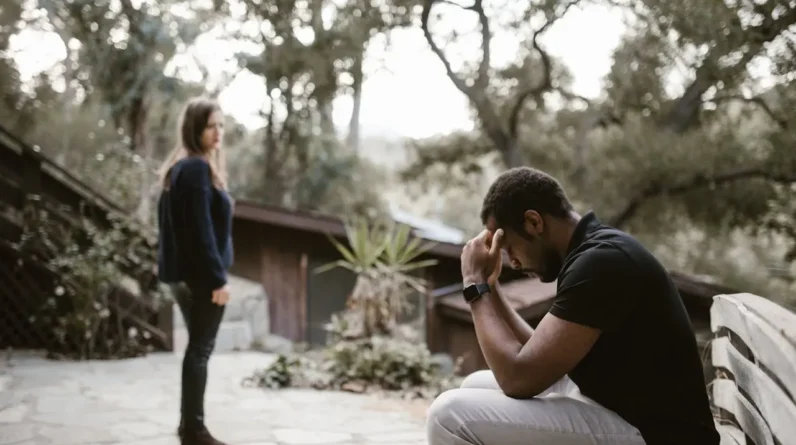
So, you’ve found yourself in a relationship with someone who’s avoidant.
One minute, everything’s fine, and the next, they’re pulling away, maybe even ghosting you. If it feels like emotional whiplash, you’re not alone.
Being with an avoidant partner can be confusing and frustrating, especially when you care deeply about them, but feel like you’re always chasing after a connection that keeps slipping away.
But here’s the thing: it doesn’t have to be a losing game. With a bit of insight, some self-care, and the right communication, you can navigate this relationship without losing yourself in the process.
…their avoidance is often a defense mechanism against their own fears, not a reflection of your worth or actions.
What’s an Avoidant Partner? 5 Revealing Signs to Look Out For
Understanding Avoidant Attachment
First, let’s talk about what you’re dealing with.
Avoidant attachment is one of four attachment styles, and it typically develops from early experiences in childhood.
People with avoidant attachment often grew up in environments where emotional needs weren’t consistently met, so they learned to rely on themselves and avoid dependency on others.
As adults, this can look like someone who’s:
- independent to a fault
- uncomfortable with intimacy
- quick to retreat when things start to get too close for comfort
Imagine trying to hug a cat that doesn’t want to be held. The more you reach out, the more they squirm, right? That’s kind of how avoidant partners operate.
It’s not that they don’t care about you; it’s that getting close feels threatening to their sense of autonomy and safety.
This brings us to an important point: their behavior isn’t about you.
I know that’s hard to believe, especially when they’re ghosting you or acting distant, but their avoidance is often a defense mechanism against their own fears, not a reflection of your worth or actions.
It’s an important thing to remember because if you internalize their behavior as a personal rejection, you’ll end up on an emotional roller coaster with no brakes.
Managing Your Emotions and Expectations
Now that you know what’s going on, let’s talk about how to handle it without losing your sanity—or yourself.
The first step is a little self-reflection.
What’s your own attachment style?
The 4 Attachment Styles: How Can They Affect Your Relationships?
Are you someone who craves closeness and reassurance, maybe even leaning towards anxious attachment?
If so, you’re in for a bit of a challenge because your natural tendencies might be to chase after them, seeking the connection they’re pulling away from. That’s where things can get tricky.
Understanding your own attachment needs is crucial, because it helps you recognize why their behavior affects you so deeply and gives you the tools to manage your reactions.
It’s not about changing who you are, but about becoming aware of your triggers and finding healthier ways to cope.
Set Realistic Expectations
This leads to the next step: setting realistic expectations.
If you’re expecting your avoidant partner to suddenly become a warm, open book who loves deep, emotional conversations, you might be setting yourself up for disappointment.
Instead, try to meet them where they are, recognizing that their way of relating might always be a bit more distant than what you’re used to.
That doesn’t mean you should settle for less than you deserve, but understanding the limits of what they can offer can help you adjust your expectations to something more attainable.
Self-care is also non-negotiable here.
When you’re with someone who has avoidant tendencies, it’s easy to get caught up in their emotional ups and downs, neglecting your own needs in the process.
Don’t let that happen!
Make sure you’re nurturing your own life outside the relationship.
- spend time with friends
- pursue your hobbies
- and practice mindfulness or other self-soothing techniques that keep you grounded
The more secure and fulfilled you are on your own, the less you’ll feel the need to chase after your partner’s elusive affection.
Communication Strategies
Okay, so now you’ve got a handle on your emotions and expectations.
But how do you actually communicate with someone who has avoidant tendencies?
The key is non-confrontational communication.
When you need to address something important, it’s all about the delivery. Avoid coming across as too demanding or critical because that can trigger their defense mechanisms, causing them to shut down or pull away even more.
Instead, focus on expressing your needs and feelings in a way that’s calm and non-threatening.
For example, instead of saying,
“You never open up to me! Why don’t you care?”
try something like,
“I really value our connection and sometimes I feel a little distant from you. I’d love it if we could talk more about how we’re feeling.”
It’s a subtle difference, but one that can make a big impact.
Another crucial aspect of communication with an avoidant partner is active listening.
When they do open up, even if it’s just a little bit, make sure you’re really listening. Show empathy and understanding, even if what they’re saying isn’t exactly what you want to hear.
The more you create a safe space for them to express themselves, the more likely they are to feel comfortable sharing with you over time.
But remember, communication is a two-way street.
While it’s important to be patient and understanding, don’t forget that your feelings and needs are just as valid. It’s okay to express when something isn’t working for you, just make sure to do it in a way that encourages dialogue rather than conflict.
Setting Boundaries Without Ultimatums
One of the most challenging parts of being in a relationship with an avoidant partner is finding the balance between giving them space and maintaining your own sense of security.
This is where healthy boundaries come into play. Boundaries aren’t about controlling the other person; they’re about protecting your own emotional well-being.
For example, if your partner tends to disappear for days at a time without much communication, you might set a boundary that you need a text or call every couple of days to feel secure in the relationship.
Or, if they pull away whenever you try to discuss something emotional, you could set a boundary that you need to have regular check-ins about how things are going, even if it’s just a quick chat.
The key is to set boundaries that are firm but flexible. You don’t want to be so rigid that you’re setting your partner up to fail, but you also don’t want to bend so much that you’re compromising your own needs.
It’s a delicate balance, and it might take some time to get it right!
Avoid ultimatums at all costs.
Ultimatums, like, “Either you open up to me, or I’m leaving,” are more likely to backfire with an avoidant partner.
They might comply in the short term, but it’ll probably lead to more resentment and emotional distance in the long run.
Instead, try to approach these issues with compassion and a willingness to find solutions that work for both of you.
Knowing When to Walk Away
While it’s possible to have a healthy relationship with an avoidant partner, it’s also important to know when it’s time to walk away.
Sometimes, despite your best efforts, the relationship might become too one-sided or emotionally draining. And that’s okay.
Ask yourself if the relationship is truly fulfilling your needs.
- Are you happy more often than not?
- Do you feel secure and valued, or are you constantly anxious and second-guessing your worth?
If you’re consistently feeling more drained than fulfilled, it might be time to reassess whether this relationship is right for you.
Red flags that the relationship might be taking a toll on you include:
- constant anxiety about where you stand
- feeling like you’re walking on eggshells to avoid triggering your partner
- or noticing that your self-esteem has taken a hit since you’ve been together
These are signs that the relationship might be doing more harm than good.
If you decide it’s time to move on, do so with kindness and compassion—both for yourself and your partner.
Remember that their avoidant behavior is a result of their own struggles, and walking away doesn’t mean you didn’t care or didn’t try. It just means that you’re choosing to prioritize your emotional health, which is something to be proud of.
Staying True to Yourself in the Face of Avoidance
Navigating a relationship with an avoidant partner isn’t easy, but it doesn’t have to be a losing battle either.
By understanding their attachment style, managing your own emotions, and communicating effectively, you can create a dynamic that respects both your needs and theirs.
And remember, it’s perfectly okay to set boundaries and even walk away if the relationship isn’t serving you.
The most important thing is to stay true to yourself.
Don’t lose sight of your own worth or let your partner’s avoidant tendencies diminish your sense of self.
With patience, empathy, and a healthy dose of self-care, you can handle this relationship—and any challenges it brings—with grace and strength.
Photo by Vitaly Gariev







